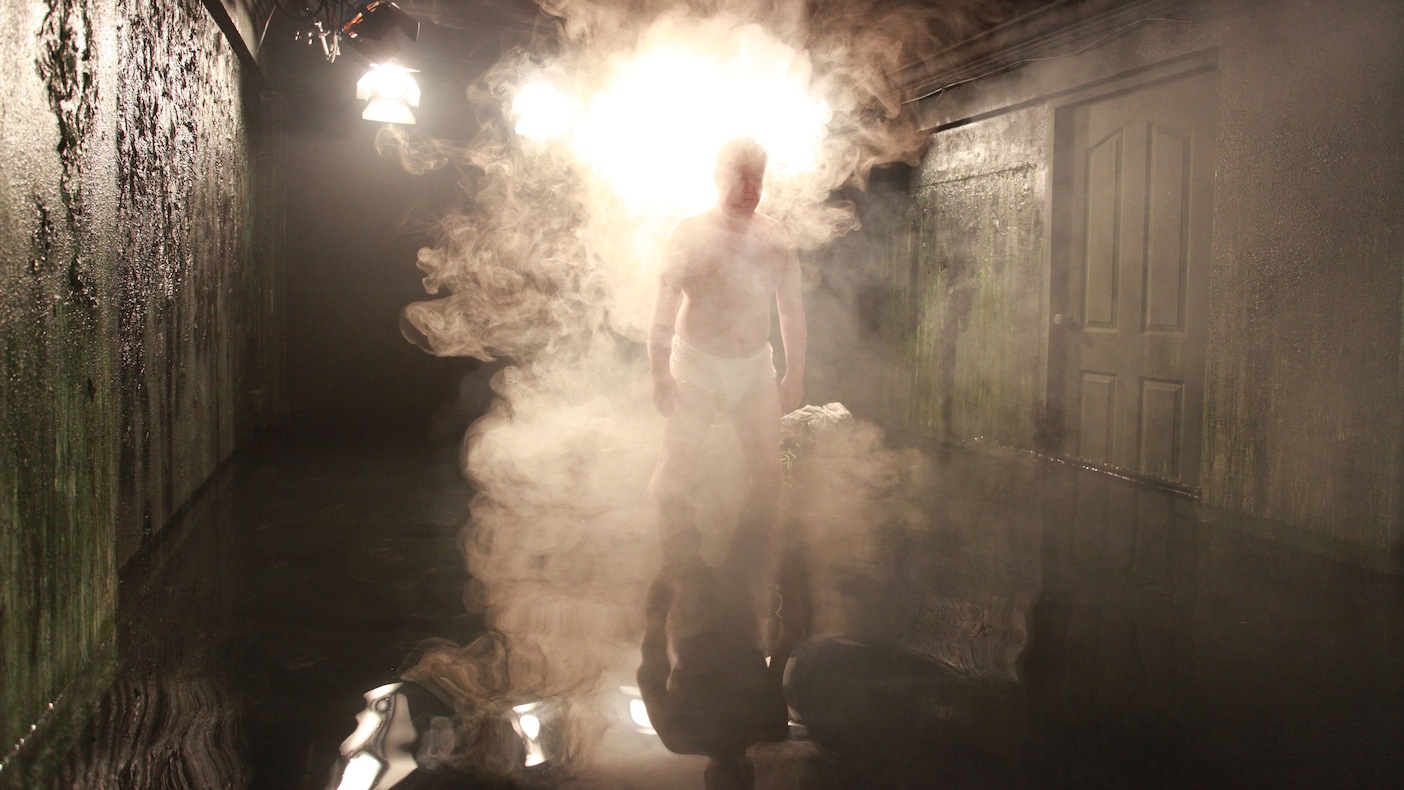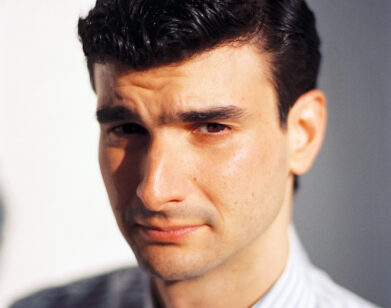Tzu Nyen Ho’s Head Is in the Clouds
Shot in a decaying block of vacated apartments in the remote outskirts of Singapore, The Cloud of Unknowing by Singaporean filmmaker Tzu Nyen Ho is fittingly flooded with ghostly presences. Misty clouds infiltrate and invade the homes of eight characters, culminating in hysterical confrontations with these inscrutable specters.
The 28-minute short will screen this month at Sundance as part of New Frontiers, a non-competition specialty slate that highlights experimental films pushing cinematic limits. When we sat down with Ho over coffee in his tropical homeland, he admitted to an obsession with the cloud as an art historical trope. Exploring the competing ideologies behind eastern and western artistic interpretations of clouds thus formed the nexus of his film. We chatted about his endeavor to weave together this floating signifier’s many complexities, and probed him for his perspective on Singapore’s contemporary art scene—or lack thereof.
MICHELLE LHOOQ: Did you know that your film shares its title with a bad Gorillaz song?
TZU NYEN HO: Yes. Actually the process I used was to just start collecting everything I could that’s related to clouds. So I collected up to 200 songs, and most of them are used in the soundtrack, even if it’s just little fragments. That Gorillaz song is in there somewhere. I hope I don’t get in trouble.
LHOOQ: The Cloud of Unknowing is also the title of a prayer book from the medieval ages. Is your work supposed to have a religious undertone?
HO: I think religious undertones are inevitable. Most of the compositions on which the film is based are drawn from paintings of clouds stemming from the Catholic Church tradition.
LHOOQ: When you were appropriating images and music, did you rely exclusively on Western sources?
HO: The starting point for the project came from a book by a French art historian Hubert Damisch, who wrote about the role of clouds in paintings. The book ends with a chapter on Chinese art, in which clouds of mist and vapors are important elements. They’re what link the heavens and earth.
LHOOQ: But that’s usually the case in western art, too. Is there a difference between the cloud’s symbolism in the east and west?
HO: For sure. In the Catholic tradition, the cloud signifies the presence of the divine and eternal. Sometimes clouds have become solid demarcations that separate the earthly from the celestial sphere. In the Chinese sense, it’s quite the opposite. Clouds are another way to express emptiness and change. The void is something transient. It’s a very different reading of the role of clouds, and I would say that I feel closer to the Chinese perspective.
I also thought of the work itself as a cloud. I wanted to make a film that’s packed dense with so many references that everyone can draw their own visions and hallucinations out of the same source. I just tried to layer a lot of sound and visual references and compress them into the work as much as possible. When you stack so many things together, they start to negate themselves. It’s like mixing too many colors on the palette. They become gray and murky, which is the state I wanted to push the work towards.
LHOOQ: Can you describe what the audience experiences when viewing your film?
HO: I’m presenting it as part of an installation, with a 13-channel sound system, as well as a smoke machine and theatrical lights. It’s a question of how to present videos in a physical space. They’ve got to do something that the cinema can’t. There has to be an extra, experiential dimension.
The whole film was shot in a deserted block of HDB (Housing Development Board) flats in Taman Jurong, a low-income area that’s as close to the ghettos as you can get in Singapore. We rented eight units, and each character inhabits a room. They’re obsessively doing activities based on existing compositions from Chinese landscapes or Western classical paintings. Close to the end of the film, it becomes more hysterical as they’re invaded by clouds, vapors, or mist. Finally, what you think is projected smoke you realize is actually coming from behind the screen. So the cloud is materialized.
LHOOQ: Would “immersive” or “permeable” be good ways to describe your use of the fog machine and surround sound in this installation?
HO: I think immersive would one way to describe it. But at the same time, I would describe this installation, and a lot of my work, as being theatrical. Theatricality by nature can be anti-immersive. As the art critic Michael Fried said, absorption and theatricality are opposite poles. The upfront acknowledgement of the spectators in front of your work is a kind of very high theatrical gesture that breaks them out of the fictional world of the film. Our use of the surround system is an example of this. I was keen to not create a system that you can find in any cinema, but rather to install speakers in strange positions so that you feel the directionality of the sound, and become aware of the presence of a subwoofer hanging above your head. My work does draw the attention of the spectator into the space itself, rather than being immersed in the world of the screen.
LHOOQ: When I first read about your film, I thought, “This reminds me of cheesy 3-D rides at theme parks, where the audience gets sprayed with water when they’re looking at mist.” But what you’re saying is the opposite. You’re not trying to make viewers feel part of the world they’re seeing. Using these special effects makes them understand that this is a work of art, which is a representation of reality rather than reality itself.
HO: That’s a good way of putting it. I don’t want my work to be either immersive or theatrical. I think there should be moments of both, so it’s an oscillating mode of tension.
LHOOQ: How important is the surrounding space to the effectiveness of your installation? It was originally displayed in a cathedral when it debuted at the Venice Biennale.
HO: This work was made specifically for that cathedral. I heard we’re going to be given an old warehouse at Sundance. Being in a difference space is part of the risk this work involves.
LHOOQ: I’m really into the creepy, elongated clouds in El Greco’s paintings. Which artists were you particularly inspired by?
HO: Coraggio’s paintings are really important for me. After the Venice Biennale, I went to Parma to look at a painting he did in a church there. I found his idea of being seduced by the formless really beautiful. A lot of Chinese painters are equally important. Because the cloud represents change, it is nothing but at the same time it is everything, which is a very typical Taoist philosophy. Chinese painters treated blank paper in the same way—a void and an infinite possibility at the same time. It’s very interesting the way Chinese artists, in a negative system, painted clouds by not painting at all. To depict a cloud, you had to leave the paper white.
LHOOQ: So the screen that your film is projected onto is also a kind of “cloud” in the same way that the scroll is a cloud. They’re everywhere!
HO: Exactly.
LHOOQ: Why did you choose to film in an HDB flat, and why are so many Singaporean filmmakers so attracted to this locale?
HO: 70% of Singaporeans live in HDB flats. It’s the environment in which I grew up and am most familiar with. But I’ve avoided filming in these flats until this point, because sometimes in films when we see representations of life in HDBs, these representations make me squirm. Either there’s a romanticization of life or a kind of superimposed pornographic misery. For this film I wanted to use this particular block of grimy flats because they’re something completely opposite to clouds. They’re like earth, with an environment that’s dense with lived experience, with age, with memory, with decay.
LHOOQ: What is it like being an artist in Singapore? How has living in this country influenced your work?
HO: On the surface, Singapore isn’t the easiest place for anyone working in the arts. I would say that it’s not the most energetic, and there’s a shortage of commercial galleries. A lot of us need to show our work abroad. But Singaporeans are a unique breed. It’s a cliché to say that we’re a bridge between the east and west. But it’s true. The problem and biggest challenge is whether we can make something of our own.
LHOOQ: Why this lack of energy though?
HO: There’s a certain dynamism in the financial and business spheres, but that dynamism hasn’t been diffused through the other sectors of life. Culturally, we’re quite conservative. It is quite safe and conservative and not too exciting. The playwright Kuo Pao Kun describes Singaporeans as descendants of a eunuch, which is a sort of spiritual castration. This is not a monolithic truth of course, but it’s not the easiest place to be.
LHOOQ: Clouds is in the process of being acquired by the Singapore Art Museum, the only museum in Singapore focusing on local art. Is that government-run institution influential in shaping the kind of discourse that goes around Singaporean art?
HO: It almost feels strange to talk about “discourse” in Singapore, because I’m not sure if we really have that. I can’t even think of one professional art critic working at the moment, except for Lee Weng Choy. For a country that regards itself as a developed, first world country, the state of artistic discourse is terrible.
LHOOQ: Singaporean artists benefit from the abundance of financial sponsorship coming from the government. Do you think that could possibly be part of the problem?
HO: It breeds a certain kind of overreliance on state funding, which inevitably becomes a form of censorship. The state only funds works that doesn’t openly critique its power, and we know that Singapore is a one-party state. But it also really just depends on how the artist uses the funding.







